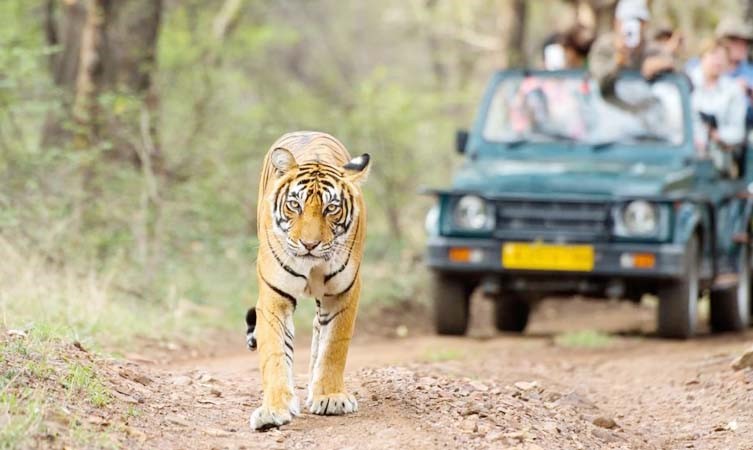Description

Disclaimer: Copyright infringement not intended.
Context
- A 76-year-old woman was mauled to death in the Kalagarh Tiger Reserve's Adnala forest range when she had gone to gather fodder for her livestock.
Highlights
- Kalagarh Tiger Reserve is located in the Terai region of Uttarakhand, India.
- It spans parts of Pauri Garhwal and Nainital districts, covering a significant area.
- The reserve is known for its rich biodiversity and its efforts towards tiger conservation.
History of Kalagarh Tiger Reserve
Pre-Independence Era
- The history of Kalagarh Tiger Reserve can be traced back to the pre-independence era when it was known as the Kalagarh Forest Division.
- During this period, the forest area was primarily managed for timber extraction and hunting, with little emphasis on wildlife conservation.
Post-Independence Era
- After India gained independence, there was a growing recognition of the importance of conserving wildlife and preserving natural habitats.
- In the 1970s, the Kalagarh Forest Division was upgraded to a wildlife sanctuary to provide protection to the diverse flora and fauna in the region.
Notification as a Tiger Reserve
- In 1974, the Indian government launched the 'Project Tiger' initiative to conserve the declining tiger population in the country.
- As a part of this initiative, Kalagarh Wildlife Sanctuary was notified as a tiger reserve in 1974, becoming one of the first nine tiger reserves in India.
Formation of Kalagarh Tiger Reserve
- The Kalagarh Tiger Reserve was officially established in 2000 with the merger of the Kalagarh Wildlife Sanctuary and the eastern part of the Corbett Tiger Reserve.
- This merger aimed to create a larger protected area for the conservation of not only tigers but also other wildlife species.

Location
- Situated in the Terai region of Uttarakhand, bordering the state of Uttar Pradesh.
- The reserve is bounded by the Ramganga River on the west and the Mandal River on the east.
- Its geographical location makes it an essential part of the state's wildlife conservation efforts.
Flora
- Kalagarh Tiger Reserve boasts a diverse range of flora, making it a habitat for various plant species.
- The forest area is dominated by a mix of deciduous and tropical vegetation.
- Prominent tree species include Sal, Bamboo, Semal, and Dhak, creating a lush and green environment.
Fauna
- The reserve is home to a wide variety of wildlife species, making it a haven for wildlife enthusiasts.
- The Royal Bengal Tiger is the apex predator and the star attraction of the reserve's fauna.
- Other prominent inhabitants include the Asian Elephant, Leopard, Sloth Bear, Wild Boar, and numerous bird species.
Tiger Conservation
- Kalagarh Tiger Reserve plays a crucial role in the conservation of the endangered Royal Bengal Tiger.
- The reserve focuses on maintaining the tiger's natural habitat and implementing conservation measures.
- Efforts are made to prevent poaching, habitat encroachment, and human-wildlife conflicts to protect the tiger population.
Importance of the Reserve
- Kalagarh Tiger Reserve is significant for the ecological balance and preservation of biodiversity in the region.
- It acts as a wildlife corridor, allowing animals to move freely between different forest areas, promoting genetic diversity.
- The reserve contributes to the state's tourism industry, attracting wildlife enthusiasts and nature lovers from all over the country.
Challenges and Future Prospects
- The reserve faces challenges like illegal encroachments, deforestation, and human-wildlife conflicts.
- Sustainable development practices and community participation are essential for the long-term conservation of the reserve.

Conclusion
Kalagarh Tiger Reserve stands as a testament to Uttarakhand's dedication to wildlife conservation. Its diverse flora and fauna, along with its focus on tiger conservation, make it an integral part of India's efforts to preserve its natural heritage. With effective conservation strategies and community support, the reserve has the potential to continue thriving as a safe haven for wildlife and a destination for nature lovers and wildlife enthusiasts.
|
PRACTICE QUESTION
Q. Consider the following statements about Kalagarh Tiger Reserve:
1.It was established as a tiger reserve in 2007.
2.Kalagarh Tiger Reserve is located in the state of Rajasthan.
3.It is one of the oldest tiger reserves in India.
Which of the statements is/are correct?
A) Statements 1 and 2 are correct.
B) Statements 1 and 3 are correct.
C) Statement 2 only is correct.
D) Statements 1, 2, and 3 are incorrect.
Answer: D
|
https://timesofindia.indiatimes.com/city/dehradun/woman-76-mauled-to-death-by-tiger-in-pauri/articleshow/102049430.cms












